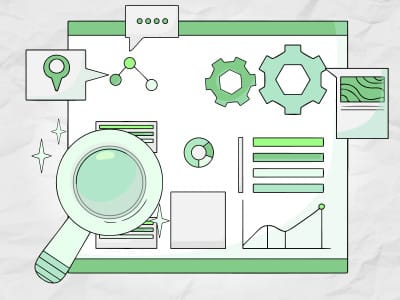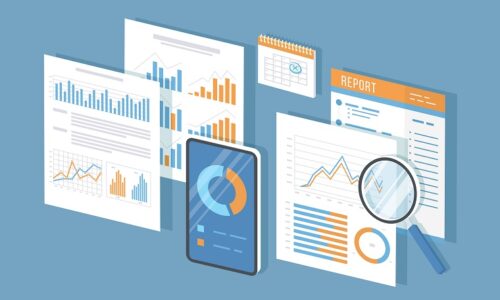
Today, everything starts with the Internet – users search for the necessary goods and services through search engines. In order for your site to be noticed among many competitors, competent SEO optimization is necessary.
SEO is a set of measures for internal and external optimization of the resource for search engine ranking algorithms in order to bring it to the first positions for the necessary queries. Internal optimization of the site is an important aspect, but insufficient. Its external search engine optimization is no less important. It is about it that we will talk about this article.
What is external site optimization?
External site optimization is a set of measures aimed at increasing the authority of a resource in the eyes of search engines using external factors that are not directly related to the code and content of the site.
The main goal is to form a powerful link profile of the site. Incoming links from other authoritative resources are regarded by search engines as “votes of trust” and have a positive effect on ranking. The process of building a link profile itself is called link building. In one of our articles, we have already told what link building is – read to learn more.
The second goal of external SEO is to attract targeted traffic to the site through mentions outside the site itself. This can be, for example, obtaining conversions through posting interesting content on third-party sites.
Thus, external SEO site optimization works to increase the two main ranking factors – the authority of the site in search engines and the influx of high-quality targeted traffic.
Differences between external and internal optimization
External SEO optimization is aimed at working with factors external to the site. Unlike internal optimization, it does not directly affect the structure, program code, content and technical aspects of the site itself.
External site promotion includes work on:
- Increasing the link mass
- Increasing the citation rate of the site on the Internet
- Presenting the resource on third-party authoritative sites
- Increasing the recognition and reputation of the brand/site
- All these are external optimization factors that require regular processing.
Internal optimization includes work on such aspects of the resource as:
- Content optimization for search queries
- Technical optimization: speed, absence of duplicates, LSU for pages, correctly configured robots.txt/sitemap.xml files, etc.
- Site Structuring and Navigation
- Improving Usability and User Experience
- Internal Page Linking
That is, internal SEO is responsible for the quality of the site itself, while external SEO promotion focuses on factors outside of it. It is the combination of both approaches that gives the maximum synergistic effect for search promotion.
External site optimization methods
There are many methods and sources for building a high-quality external link profile. Let’s consider the main ones:
Forums
Posting comments on thematic forums that contain links to your site is one of the natural ways to get links, the so-called “word of mouth”. Participate in discussions on relevant forums and leave useful comments: such links should be natural and unobtrusive so as not to cause a negative reaction from moderators and users.
Directories
Registering a site in authoritative thematic resource directories is also often used to strengthen the link profile. Registration in directories for foreign businesses is especially valuable, so if you need to promote your site abroad, consider local listings. Placing links in local business directories will help users looking for specific services find your site. However, you should not abuse free directories. Many of them today have many drawbacks (long queues for moderation, business pages closed from indexing, lack of search traffic, etc.). Pay attention to the placement fees.
Guest articles
Placing unique thematic content with links on third-party authoritative portals or blogs is a great option to get quality links. At the same time, the articles should be really interesting to the site’s audience. You can post articles yourself (if the site’s functionality allows it) or negotiate placement with blog owners (for example, offer them a list of topics that may interest their audience).
Link purchase
Purchasing links to promote a site on exchanges or from individual webmasters helps to quickly increase the number of links. Very often, external search engine optimization of a site is based on purchasing placements – it is convenient and affordable. But you need to carefully choose donors and exercise moderation so that link building looks natural and your control profile does not grow too rapidly – for a search engine, this may look suspicious. What is a good link exchange and how not to make a mistake when working with purchases – read in one of our articles.
Links from partner sites
Bartering links with business partner sites can also be a good addition to your link profile. In this case, it is important to adhere to the principle of link equivalence. Often, partners agree on such placements in advance, perhaps even before the site is created. That is why it is important to conduct SEO before launching the site – this will allow you to take into account all such nuances.
Viral marketing
Creating viral content can contribute to the natural growth of links. Viral content includes articles or notes on a provocative topic, funny videos, humorous publications, which in themselves encourage users to share them on social networks or other sites.
Interview, press release
Giving an expert interview or posting a press release on the website of the relevant media is not only good PR, but also a way to earn backlinks to your site. The main thing is that the material is really interesting and valuable for the publication’s audience.
What types and types of links are there
By anchor type
- Anchors – links that contain keywords in the text part (anchor). For example: buy a smartphone. They help with ranking by these keywords.
- Anchorless – links that do not contain keywords, instead of an anchor, use the URL itself, for example, https://example.com or use the words “here, on the site, price” or similar.
- Branded – links with a mention of the brand/site name in the anchor.
By type of donors
- Rental or temporary – links placed on a commercial basis with a limited lease term. After the lease expires, they are deleted.
- Eternal – purchased links that are valid permanently and have no term limits. The most valuable for promotion.
- Barter – exchange of links between two sites without monetary relations.
By attributes
- Nofollow — links with the attribute rel=”nofollow”, which do not transmit the number of links from the donor site to the recipient site, but are important for maintaining the naturalness of the link profile.
- Dofollow — standard links that a search bot can follow, this type of link is important for promotion, as they transmit link weight.
- Sponsored — an attribute of external links to indicate advertising/sponsored content.
- UGS (User-Generated Content) — an attribute of links for content created by users.
How to analyze the link mass of sites
Analysis of the link mass of a site is an important stage in SEO, which helps to understand how effective your external optimization strategy is and how it can be improved. It is with the analysis that optimization of external factors of a site begins. This process includes assessing the number and quality of external links, determining the authority of donors, analyzing anchors and identifying malicious links. Let’s consider in more detail how to properly analyze a site for external links.
1. Using tools for analyzing link mass
There are many tools for analyzing backlinks, each of which provides unique capabilities and data. The most popular of them are:
- Ahrefs. One of the most famous and popular tools for analyzing links. It allows you to find out the number of links, donor domains, a list of anchors, as well as assess the authority of the site – Domain Rating (DR).
- SEMrush. Another powerful tool for analyzing links, which allows you to track backlinks, analyze competitors and find new opportunities for building a link profile.
- Moz Link Explorer. This tool offers a user-friendly interface for analyzing link mass. You can also analyze a variety of different metrics, such as Domain Authority (DA) and Page Authority (PA).
- Majestic SEO. A specialized link analysis tool that offers its own metrics, such as Trust Flow and Citation Flow, to help you evaluate the quality and quantity of links.
2. Link Mass Assessment
After choosing a link analysis tool, the first step is to determine the total number of backlinks and unique domains. It’s not just the number of links that matter, but also their quality. High-quality links from authoritative and relevant sites carry more weight and have a positive impact on SEO.
You can assess the quality of links using the following criteria:
- Use metrics such as Domain Authority (DA) or Domain Rating (DR) to determine how authoritative the donor site is.
- Evaluate the relevance of backlinks — links from sites related to your niche are more important for SEO.
- Sites with high traffic are generally considered more authoritative.
3. Anchor Analysis
Anchors are words or phrases used in a hyperlink to link to your site. Proper use of anchors plays an important role in SEO. For link optimization to be truly successful, it is important to maintain a balance between different types of anchors to avoid keyword stuffing, which can be perceived by search engines as spam and manipulation.
4. Identifying and eliminating bad links
Toxic or bad links are low-quality or spammy links that can negatively affect your site’s search engine rankings. Such links can come from low-authority sites, sites that violate search engine rules, etc.
To identify toxic links, use the capabilities of the SEO tools we mentioned above. Once you have identified the links, you can:
- Try to remove the link — contact the owner of the donor site and ask them to remove the link from the page.
- Disavow the link using Google’s Disavow tool — if removing the link is not possible. This signals to Google that the links (or domains) you have flagged should not be considered when ranking your site.
5. Monitor and analyze your main competitors
Analyzing your competitors’ link profiles will help you identify new opportunities to build your own link profile. Use link analysis tools to determine where your competitors are getting their links from, find reputable donors who may also be linking to your site, assess the quality of your competitors’ link profiles, and compare them to yours.
6. Regularly monitor your link profile
SEO is a dynamic industry, and changes in your link profile can occur all the time. Link optimization should definitely be part of your strategy. Regular monitoring and updating of your link profile will help you maintain high positions in search results and adapt to changes in search engine algorithms.
How to choose the right donor sites when buying links
Buying backlinks is one of the fastest and most effective methods of external optimization. However, success largely depends on the right choice of donors.
It is worth paying attention to the following factors:
- Thematic proximity of the donor to your niche. Links from relevant resources have more weight.
- Authority, traffic and quality of the donor (can be checked using various tools and services). The more authoritative the donor, the higher the value of the link.
- The minimum number of outgoing links on the placement page – less competition for weight transfer.
- Domain age – old sites with a history are better than young projects.
- Compliance with anti-spam algorithms of search engines – rejection of donors with signs of spam and sanctions.
It is better to buy links little by little from the maximum number of donors than to place many links on one site. This will make your link profile look more natural and secure.
Mistakes in external optimization
Making mistakes in the process can not only not achieve the desired results, but also harm the site. Here are some of the most common mistakes in working with external links that you should avoid:
- One of the biggest mistakes is buying links from low-quality sites. Such links can quickly increase the number of links, but they do not bring any benefit and can even cause harm. Sites that sell low-quality links often have a bad reputation and can be banned by search engines. It is better to invest your efforts and money in quality links from authoritative resources.
- Oversaturating anchors with keywords is a common mistake that can lead to pessimism of your ranking in the eyes of the search engine. Anchors should be diverse and natural. Using the same anchors in most links can cause search engines to suspect ranking manipulation.
- Links from irrelevant sites may not benefit your SEO, and in some cases, even harm it. It is important that the donor sites are thematically related to your site. This will not only improve the quality of the link profile, but also make it more natural. If there are few sites with relevant topics, pay attention to donors that contain relevant headings that suit you and are in harmony with the general niche of the site (most often news resources meet this criterion).
- The balance between nofollow and dofollow links is important for the naturalness of the link profile. The complete absence of nofollow links can arouse suspicion, since natural profiles contain a mixture of both types of links. Similarly, the predominance of nofollow links can reduce the effectiveness of off-site optimization.
- Many site owners forget to regularly check and update their link profiles. This can lead to the accumulation of low-quality links, which over time can negatively affect SEO. Regular analysis helps maintain a high-quality control profile and timely eliminate potential problems.
- Ignoring local SEO can lead to missed opportunities to improve visibility in search. Local links help improve positions in regional search results and help attract the target audience.
Some mistakes in external promotion are made simply due to lack of experience. This can be the insidiousness of SEO promotion with your own hands: you can learn the basics and do everything by the book, but in practice sometimes situations arise in which you do not know how to help the site.
Therefore, we recommend that you entrust the promotion to professionals – contact the SEO agency BirinciSEO. Our team has extensive experience working with sites of different sizes, niches and geographies, so we can find an approach that is right for your resource.
Checklist for off-page optimization of the site
Effective off-page optimization of sites requires a systematic approach and careful planning. The following checklist will help you avoid common mistakes:
- Conduct an analysis of the link profile — yours and your competitors. Identify weaknesses that need to be worked on.
- Develop a strategy for obtaining high-quality links that is appropriate for your resource. When developing a strategy, define goals, draw up an action plan that includes methods of obtaining links (guest posts, directories, forums, etc.).
- Obtain links from authoritative and relevant sites. Focus on sites of good quality and appropriate thematic relevance.
- Use various types of links. Use keywords in the anchor text, but do not abuse them. Use common phrases or URLs as anchors. Include the name of your brand or company in the anchor text.
- Regularly analyze and adjust the strategy. Monitor changes in your link profile and check new links for quality.
- Remove spammy, malicious, toxic links. Use Google’s Disavow tool to disavow unwanted links.
- Consider local SEO. Get links from local resources (regional directories, business listings, etc.).
- Use crowd-marketing. Participate in discussions on forums, blogs, and other platforms related to your niche. Place links naturally, ensuring their usefulness and relevance.
Conclusions
External SEO of the site promotion is a mandatory component of a full-fledged SEO strategy, necessary for achieving high positions of your site in search results. Building up quality links increases the number of links and authority, increasing the chances of ranking. In addition, links on other resources can provide an influx of targeted traffic.
Success here is determined by the competent choice of methods for obtaining backlinks and the choice of high-quality, relevant donor sites. It is important to adhere to the naturalness and proportionality of the link profile, to avoid obvious spam link surges.
The work must be carried out systematically, constantly analyzing the results, changes in search algorithms and the actions of competitors. The combination of external optimization with internal work on the site and high-quality content marketing will ensure maximum effectiveness of the promotion as a whole.




